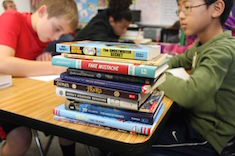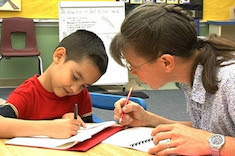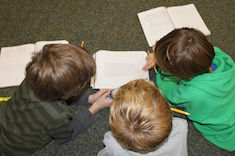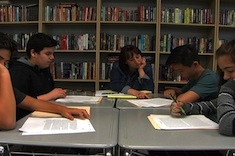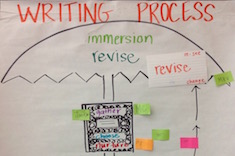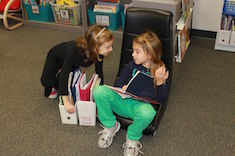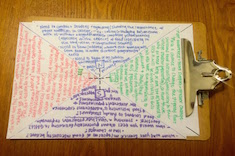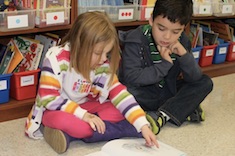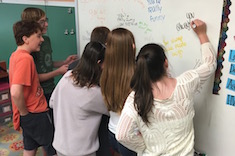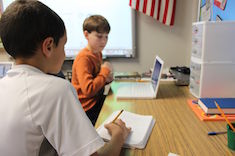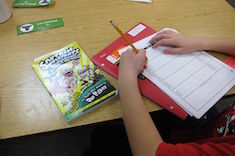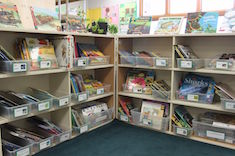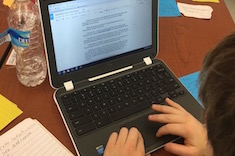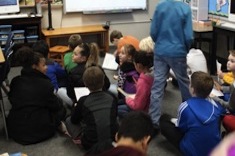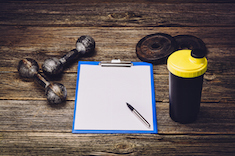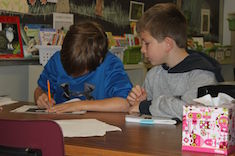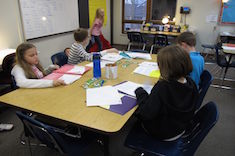Articles
Here is where you’ll find all the latest print features from our contributors. If you’d like to browse specifically by grade level, topic, or contributor, you can use the links in the right sidebar.
Latest Content
Comics and Graphic Novels for Tweens
Comic books and graphic novels are genres tweens adore, but teachers sometimes struggle to embrace. Ruth Shagoury creates a booklist with engaging books in the genre any teacher would enjoy.
Conference Records That Stay with Kids
Ruth Ayres explains why conferring records that stay with kids are useful for teachers.
Conferring Notes
When it comes to conferring notes, form needs to follow function. Dana Murphy quit looking for the perfect template, and started focusing on what kinds of notes are most helpful.
Launching a Historical Fiction Genre Study
Tara Smith finds her sixth graders love historical fiction, but they often lack the background knowledge to understand texts fully. She launches her historical fiction unit with a careful mix of discussion, anchor charts, and shared texts.
Content and Context
Melanie Meehan considers content and context for students who struggle to master new skills because of a lack of background knowledge.
Rethinking Spring Assessments
It's May, and teachers everywhere are preparing for final assessments of students. Jennifer Schwanke explains why it might be time to rethink or even ditch some of those plans.
More Scholarly Discussions in Middle School
“Eat my shorts!” Christy Rush-Levine overhears a student comment in a literature group, and begins a quest to teach her students strategies for more appropriate and thoughtful conversations around texts.
Know and Wonder: Deepening Reflection at the Start of Texts
Tara Barnett and Kate Mills use a know-and-wonder activity to encourage curiosity and independence as their seventh graders begin a new text.
Independent Project Hiccups
Tara Barnett and Kate Mills conclude their series on independent projects with advice on how to handle issues that often crop up as students design and work through writing their projects.
Improving Turn-and-Talks
Melanie Meehan shares questions and reflection prompts to make the turn-and-talk strategy more effective.
Compass Points and Empathy
Andrea Smith uses the “compass points” strategy to provoke better whole-class discussions and reflection during read alouds.
My World Maps
Creating “world” maps is a great way to explore the territories beyond school that matter most to everyone in your classroom. Suzy Kaback explains how to create them with students early in the year as a way to get to know them as learners and community members.
Authentic Reading in Kindergarten
Dana Murphy realizes the best way to introduce students to reading in kindergarten is to apply the principles that work at home with her own children.
One Child, Many Stories
Asking the right questions of family members can get you far more valuable information than anything from an assessment, especially when you are dealing with English language learners. Stella Villalba explains why initial meetings with new families are crucial.
Spreading Love with Compliments
Tara Barnett and Kate Mills close out the year in their eighth-grade classroom with a compliments activity.
Summer Reading
Bitsy Parks reflects upon her own not-so-successful experiences as a parent in getting her four children to read during the summer months. She uses these parenting lessons to help students take the initiative for summer reading by writing down commitments and goals in her first-grade classroom.
Looking Forward with Students
Melanie Meehan uses reflective questions and video to build a library of materials at the end of the year to use with next year's class.
Puppy Chow
How do you know an assignment is authentic and worthy of your students' time? Suzy Kaback explains why you need to try it out yourself first.
Using Tech to Find Authentic Audiences for Student Writing
Matt Renwick discovers technology provides many authentic audiences for student writing.
Reimagining Reading Logs
Reading logs have fallen out of favor in many classrooms because they often become a rote activity for recording pages read. Tara Barnett and Kate Mills find authenticity with the logs comes when they move from emphasizing recording to goals and reflection.
Weeding a First-Grade Library
Bitsy Parks has a simple seven-step process for a hard day’s work of weeding out her first-grade classroom library.
Books on a Budget
There are scores of new children’s books that continually tempt teachers. But how do you stock your classroom library with a limited budget? Shari Frost shares proven strategies.
Managing Independent Projects
Tara Barnett and Kate Mills continue their series on independent projects with nuts and bolts advice on management.
Literacy and Global Competence
“China is going to kill us all!” This quote from a student causes Matt Renwick to stop and consider how schools can use literacy to promote global understanding.
A Year of Learning About Student Refugees
Did you know the average length of stay in a refugee camp is 17 years? That’s only one of the many astonishing facts Stella Villalba learned as she worked to learn more about the needs of the refugees in her school district.
A Variety of Share Sessions
Ruth Ayres catalogs her favorite types of share sessions (from old favorites to creative innovations) in writing workshops.
A Community Reads “Wonder”
Katherine Sokolowski had a dream — her whole community reading and celebrating the same book. She explains how she helped coordinate, organize, and purchase hundreds of books for a community-wide reading of Wonder.
The Writing Workout
Suzy Kaback meets with a group of teachers to talk through struggles in the writing workshops. Using a fitness analogy, they come up with strategies to try immediately in their classrooms.
Backward Chaining
How do you help students who are far behind their classmates in tackling writing projects, and have had years of learned helplessness in approaching complex tasks? Melanie Meehan takes on the challenge with a backward-chaining model.
Why We Like Independent Writing Projects
One way to get all students excited about writing workshop is through independent projects. Tara Barnett and Kate Mills explain why they devote many Fridays to independent projects. This is the first installment in a three-part series.
Browse Content By
Type
Category
- Assessment Tools
- Big Fresh Archives
- Booklists
- Choice Numeracy
- Classroom Design
- Common Core
- Community Building
- Conferring
- Content Literacy
- Digital Literacy
- English Language Learners
- Equity
- Family Relations
- Free Samples
- Guiding Groups
- Leadership
- Literacy Coaches
- Mentor Texts
- Minilessons
- New Teacher Mentors
- Podcasts
- Poetry
- Quote Collections
- Reading Strategies
- Self Care
- Struggling and Striving Learners
- Talking and Listening
- Teacher Study Groups
- Teaching Reading
- Teaching Writing
- Word Study and Vocabulary
Author
- Melissa Quimby
- Nawal Qarooni
- Gwen Blumberg
- Julie Cox
- The Lead Learners
- Hannah Tills
- Josie Stewart
- Ruth Metcalfe
- Mallory Messenger
- Becca Burk
- Jodie Bailey
- Vivian Chen
- Mary Brower
- Tiffany Abbott Fuller
- Stephanie Affinito
- Ruth Ayres
- Leigh Anne Eck
- Heather Fisher
- Shari Frost
- Julie Johnson
- Suzy Kaback
- Gigi McAllister
- Shirl McPhillips
- Melanie Meehan
- Cathy Mere
- Debbie Miller
- Tara Barnett and Kate Mills
- Tammy Mulligan
- Dana Murphy
- Bitsy Parks
- David Pittman
- Brenda Power
- Heather Rader
- Matt Renwick
- Mandy Robek
- Christy Rush-Levine
- Gretchen Schroeder
- Jen Schwanke
- Brian Sepe
- Katherine Sokolowski
- Stella Villalba
- Jennifer Vincent
Grade Level
Choice Literacy Membership
Articles
Get full access to all Choice Literacy article content
Videos
Get full access to all Choice Literacy video content
Courses
Access Choice Literacy course curriculum and training

